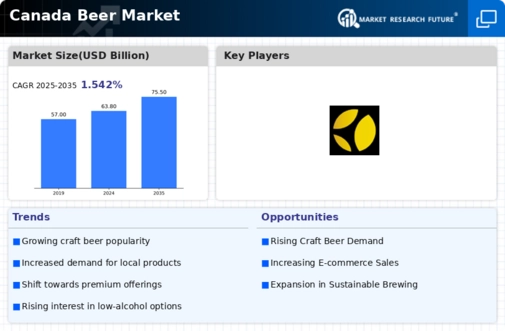Sustainability Initiatives
Sustainability is emerging as a critical driver within the beer market in Canada, as consumers become more environmentally conscious. Many breweries are adopting eco-friendly practices, such as utilizing renewable energy sources and implementing waste reduction strategies. This shift is not merely a trend but appears to be a fundamental change in how businesses operate. For example, breweries that prioritize sustainability may see a competitive advantage, as approximately 60% of consumers express a preference for brands that demonstrate environmental responsibility. Consequently, the beer market is likely to witness an increase in sustainable product offerings, which could reshape consumer purchasing behavior and brand loyalty.
Evolving Consumer Preferences
The beer market in Canada is currently experiencing a shift in consumer preferences, with a notable inclination towards unique flavors and artisanal products. This trend is reflected in the increasing popularity of craft breweries, which have seen a growth rate of approximately 20% in recent years. Consumers are increasingly seeking out local and innovative options, leading to a diversification of offerings within the beer market. This evolution in taste preferences is prompting established brands to adapt their product lines to include more experimental brews, thereby enhancing their market presence. As a result, the beer market is becoming more dynamic, with a wider array of choices available to consumers, which may further stimulate growth in the sector.
Cultural and Social Influences
Cultural and social factors are significantly shaping the beer market in Canada. The rise of social media and craft beer culture has fostered a community-oriented approach to beer consumption, where experiences and storytelling play a crucial role. Events such as beer festivals and tasting events are becoming more prevalent, encouraging social interaction and brand engagement. This cultural shift is likely to enhance consumer loyalty and drive sales, as approximately 70% of consumers report being influenced by social media in their purchasing decisions. Consequently, the beer market is adapting to these social dynamics, with brands increasingly focusing on community-building initiatives and experiential marketing strategies.
Regulatory Changes and Compliance
The beer market in Canada is influenced by ongoing regulatory changes that affect production, distribution, and sales. Recent adjustments in taxation policies and alcohol distribution laws have created both challenges and opportunities for market players. For instance, the introduction of new licensing frameworks has enabled smaller breweries to enter the market more easily, fostering competition. Additionally, compliance with health and safety regulations is becoming increasingly stringent, which may require investment in quality control measures. These regulatory dynamics are shaping the operational landscape of the beer market, compelling businesses to innovate and adapt to remain competitive while ensuring compliance with legal standards.
Technological Advancements in Brewing
Technological innovations are playing a pivotal role in the evolution of the beer market in Canada. Advancements in brewing technology, such as automation and data analytics, are enhancing production efficiency and product quality. These technologies enable breweries to optimize their processes, reduce costs, and improve consistency in flavor profiles. Furthermore, the integration of e-commerce platforms is transforming how consumers access products, allowing for direct-to-consumer sales. This shift is particularly relevant as online sales in the beer market are projected to grow by 15% annually. As a result, breweries that leverage technology effectively may gain a competitive edge in an increasingly digital marketplace.












Leave a Comment